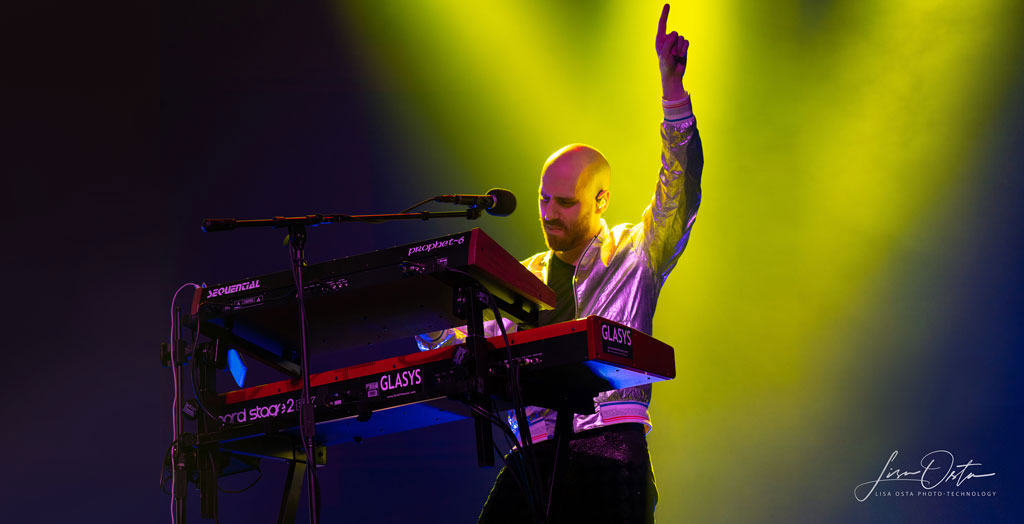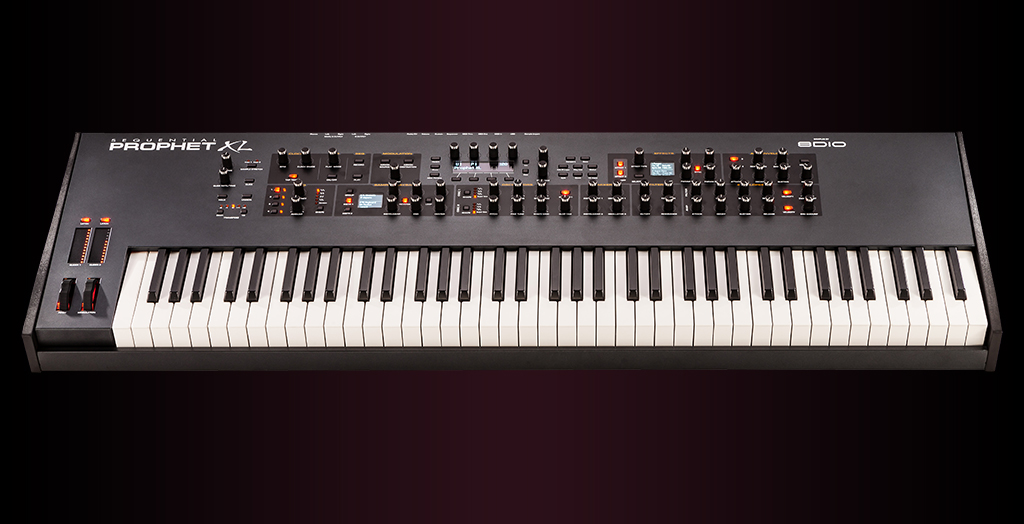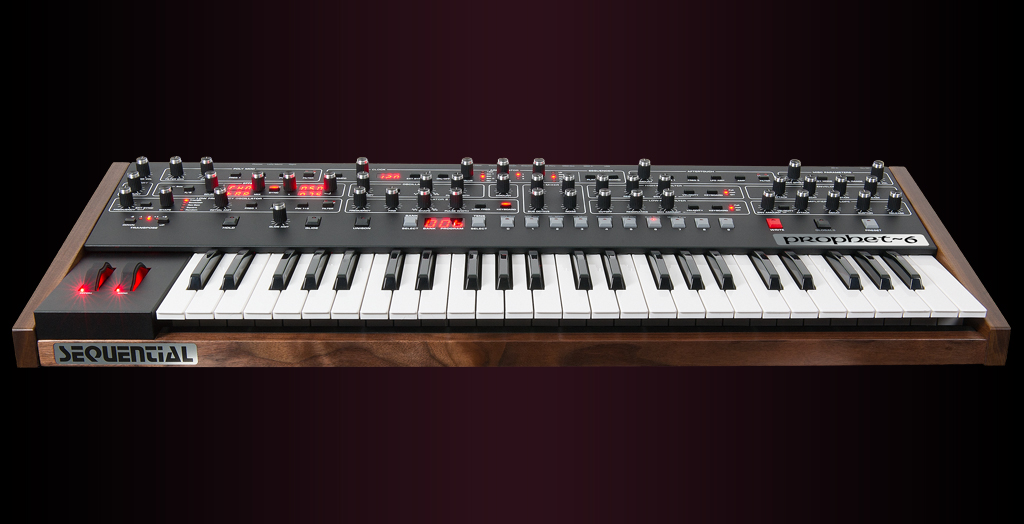
Featured Artist Gil Assayas (GLASYS)
Gear Used
SEQUENTIAL INTERVIEW – GIL ASSAYAS
GLASYS (Gil Assayas) is a pianist, synthesist, producer and vocalist who delivers intricate, virtuosic keyboard parts, electronic soundscapes, and impassioned vocals in one package that combines his many influences including Electronic music, Alternative Rock, Jazz, and Classical music. Since playing his first solo show two year ago, GLASYS has been endorsed by major gear manufacturers such as Sequential, Nord Keyboards, and Spectrasonics, and has developed a large social media presence with over two million total video views. GLASYS has also been featured on the Grammys® website, and has had his song “The Pressure” played at a Portland Trailblazers NBA game. Recently, he was discovered by Hip-Hop giant T-Pain on reddit and the two are now collaborating. GLASYS is also currently touring with legendary 70s-80s band Utopia, led by Todd Rundgren.
“HOLY. SHIT! I’ve never seen anything like this in my life. Man. PM me if you wanna work together, bro. This is amazing!” – T-Pain
“A master at the keys, Israeli instrumentalist Gil Assayas shares animated vocals with faultless keyboard and synth playing to make jazzy electronic you can’t help but dance to.” – The Deli, Portland
“From the first bar of the title track of Glasys’ debut EP “The Pressure,” it is already clear that Gil Assayas is a musician of rare talent and skill. The Portland-based Assayas is possessed of rather intimidating piano chops and assembled an impressive collective of musicians for the project.” – Jonathan Wilson, Northwest Music Scene
“Glasys, one of the best new acts to emerge out of Portland in quite some time. The brainchild of producer extraordinaire Gil Assayas, Glasys layers gorgeous keyboards on top of poppy, delicate vocals.” – Marissa Abruzzini, Tour Worthy
How did you first get started with music? Was it nature or nurture for you: Were you a self-starter or was it something that you grew into?
“My parents are both classical musicians so I grew up in a very musical home. I started taking violin lessons at the age of 7 and picked up the piano a couple of years later. Eventually, I decided to quit the violin and stick with the piano.”
It seems that some musicians have a sort of “eureka” moment in their early years where the lightbulb comes on and they realize “This is what I need to be doing.” Do you recall anything like that for you?
“Yes. When I was 14 I was going to the Jerusalem school of music and dance and I remember hearing a Jazz pianist by the name of Omri Mor (who was a few years older than me) play an Oscar Peterson tune. I hadn’t been exposed to a lot of Jazz music before that, and his playing completely blew my mind. I remember asking him for the sheet music, and when he told me that he had in fact improvised most of it, my jaw dropped to the floor. At that moment, I realized that I had to learn how to play like that and immediately started taking Jazz piano lessons.”
Tell us about your first synth!
“My first synth was actually a Workstation, A Roland Fantom X that I bought when I was 18 and was into Indie/Alternative music. For the first couple of years, I only played presets and tweaked them without really understanding what I was doing. I liked the sounds but was too afraid to learn how to program new ones, it involved a ton of menus and strange acronyms and seemed super complicated. But one day my curiosity got the best of me and I decided to actually read the manual… again and again till I memorized every parameter on the synth. It took a lot of time and practice but I eventually became a pro at creating new sounds on the Fantom X. Little did I know at the time that actual knob-per-function synths existed. I didn’t even know what an analog synth was!”
Do you usually design your own sounds? If so, how do you approach that? Do you have a process?
“Yeah, 99% of the sounds I use are designed from scratch. I find it easier to sculpt the sound I’m hearing in my head than to audition hundreds of presets hoping to find something that resembles it. That’s why I love synths that have a great raw tone, like the Prophet-6. It doesn’t take much work to create beautiful sounds, the basic oscillators and filters already sound so alive. I love simple and intuitive layouts, and I’m not a fan of having an overwhelming number of options or parameters to deal with. My process is simply to start with a default patch and sculpt the sound until it matches what I hear in my head or until I stumble across a new sound that inspires a musical idea.”
What kind of things get you excited about an instrument?
“In the past, any cool analog synth or keyboard instrument would get me excited, but nowadays I get excited by an instrument that either lets me create sounds that I can’t produce with my other instruments, or simply lets me create familiar sounds more easily and efficiently. That’s why I fell in love with the Prophet X — the combination of high quality samples, analog filters and a knob-per-function interface enables me to design sounds that would otherwise be very tedious to program with a computer — within seconds. In the short time that I’ve had the Prophet X, I’ve done whole productions using nothing but that synth. It’s improved my workflow so much that I can’t imagine working without it anymore.”
When you get a musical idea how do you go about developing it? Can you give us an example?
“It really depends on how I got the idea in the first place. Sometimes I’ll stumble upon an inspiring sound with my synths and pedals, in which case I’ll record the idea immediately and start layering other sounds on top of it until I figure out what I want it to be. Other times I’ll improvise on the piano and find a chord progression, riff, or melody that I think is worthy of a song, in which case I’ll usually spend a period of time (anywhere from a few hours to a whole year) fleshing out the idea until it’s complete. When I’m songwriting, I usually don’t arrange or produce the song until it’s done.
And then, in some other cases, an idea will suddenly pop into my head (with a complete arrangement and everything) which I’ll then try to recreate one piece at a time. These ideas usually appear when I’m trying to fall asleep at 3AM, and they don’t always end up sounding the way I imagined them.”
Do you have certain musical ideals? Certain things that you strive for?
“When it comes to my own compositions, it’s very important to me to stay authentic and true to myself, to only create music that I’m proud of. It’s not always easy to stay uninfluenced by people’s opinions these days with everyone letting you know exactly what they liked and didn’t like about your music on social media, but I do my best. I strive to remain motivated by the art itself and not by view counts or likes. On a technical level, I’m always striving to be a better player.”
Generally speaking, are you happier in the studio or on stage?
“It’s the balance between the two that keeps me happy. If I’m strictly doing studio work I get uninspired and depressed after a while, but if I perform too much and have no studio time I end up feeling burned out and exhausted. I enjoy doing both.”
What are you listening to these days?
“I’m mostly listening to the music my friends make. I have a lot of extremely talented friends and I enjoy checking out their creations, learning from them and finding new inspiration. Some examples are Coco Columbia, The Secret Sea, Sama Dams… there are so many! I also follow a lot of younger Jazz musicians like Jacob Collier and Louis Cole because I learn so much from them.”
What kinds of things inspire you — musically or otherwise. Has this changed over time?
“I’m inspired by fresh ideas and authenticity and I’ve always preferred darker music that pierces your soul rather than happy party music. It’s not that I don’t enjoy a good funk song, it’s just that the ‘put your hands in the air’ stuff often feels like a distraction from life, whereas darker music that addresses your deeper feelings feels like therapy. Life’s hard, and I listen to music that reflects that.”
Do you have a musical bucket list?
“My bucket list keeps growing, I can barely keep up with it. I have a lot of video ideas for my YouTube channel, I’m working on an album, I want to create a cool new live show and tour a lot in 2019. There are lots of musicians I want to collaborate with as well, I plan on doing more of that this year.”
What made you choose Sequential?
“I remember hearing Prophet ’08 demos years ago when I was living in Israel and being blown away by the sound. I eventually convinced a friend of mine who owns a music store in Jerusalem to start to start importing Sequential stuff and I’d spend hours jamming on the Prophet ’08 every day. When the Prophet-6 came out, I knew it was the perfect synth for me and I purchased it shortly after moving to the US. Around 90% of my upcoming album is created with the Prophet-6, and many of my YouTube videos feature it as well. It’s definitely my go-to synth for any analog sound.”
What’s one of your favorite things about Sequential instruments?
“First of all, they sound amazing and alive. But they’re also so balanced and well designed. I’ve rarely had to open the manual to figure out how to do something. If there isn’t a knob for it (which there usually is) then it’s just a couple of button presses away. I also love the Slop function.Oscillators that drift slightly out of tune sound so pleasing and human to me, and it’s so nice that you can control the amount.”
How are you using Sequential instruments in your music?
“I use the Prophet-6 for most of the analog sounds in my productions: pads, leads, bass, etc. My music is mostly electronic and these types of sounds are featured heavily. I recently got the Prophet X and I’ve been using it for sample-based sounds, cinematic sounds, and analog/sample hybrid stuff. I’ve only scratched the surface of what it can do.”
Any interesting tricks or techniques you’d like to share?
“Modulating the effects on the Prophet X is a lot of fun, I’ve created some cool sounds by assigning the wheel and sliders to effect parameters. Reversing samples and modulating their start/end times can lead to some very unique sounds as well. On the Prophet-6, I love using polyphonic glide and playing 6-voice chords. You can hear each individual voice find its own path to another note and it sounds so great.”
LINKS
https://www.facebook.com/GLASYSmusic/
https://www.instagram.com/glasysmusic/
https://twitter.com/GLASYSmusic
https://www.youtube.com/user/GilMusicVideos
“The Pressure” on iTunes: https://itunes.apple.com/il/album/the-pressure-ep/id1149758375
“The Pressure” on Spotify: https://open.spotify.com/album/6LUj1K4eMLNThOKtLfPWJr


